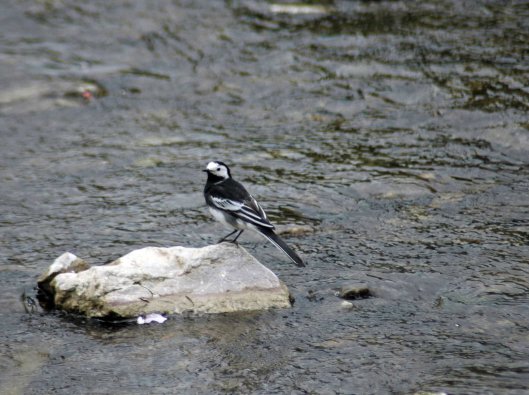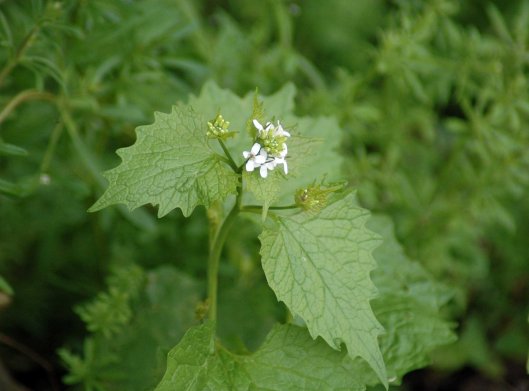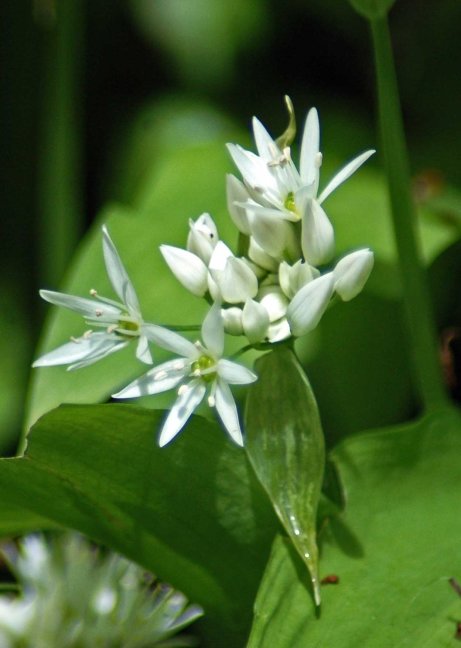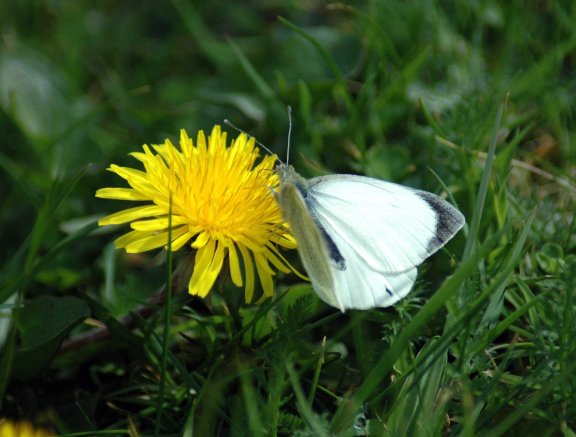Tags
cuckoo pint, dog violet, Fairy Glen, horsetail, ivy-leaved toadflax, marsh marigold, min-y-don, osmia rufa, Pied Wagtail, ramsons, red mason bee, river Colwyn, song thrush, spring flowers
Last Friday was a day typical of our Spring so far this year, overcast, showery and cool, but as I began driving home at lunchtime the sun came out, so I stopped by the little bridge at Min-y-Don woods as I often do, just to have a quick look at whatever is about. Today that was small birds flying back and forth across the river that I thought may have been Chiffchaff, but turned out to be House Sparrows taking drinks and chasing flies over the water. Then near the bend in the river I caught another flash of bird movement that made me think ‘grey wagtail’. Of course I had to follow it, being ever hopeful of a good photo opportunity. I finally caught up with the bird and saw it was actually a Pied Wagtail that was by now intent enough on catching insects not to be too disturbed by my presence.
Maybe he has a nest nearby and was out hunting for food to feed young ones, or maybe because he was alone, perhaps has a mate still sitting on eggs and he was feeding her, or, maybe he was simply feeding himself. Whatever his aims, he was very entertaining to watch and seemed to be catching plenty of insects.
A couple passing by stopped to see what I was photographing and told me they had seen the grey wagtails further upstream, so I had to carry on walking then, just in case.
On the way up to Fairy Glen my eye was caught by a mass of bright green liverwort at the mouth of a drainpipe, giving the impression it was cascading out like water.
Flowers are generally late this year, but they are making up for lost time now. On the stone walls bounding the river and roadside, the pretty, albeit non-native Ivy-leaved Toadflax flourishes.

Ivy-leaved Toadflax- cymbalaria muralis. A native of Mediterranean Europe, but widely naturalised elsewhere
And here and there the darker purple-blue blooms of the Common Dog Violet peeked out.
Garlic mustard is beginning to show its modest white flowers; I love the shape and texture of its leaves too.
Just inside the woodland of the Glen a few stands of graceful bluebells arch up through the masses of almost-done lesser celandines, surrounded by encroaching wild garlic.
Further into the woodland the air was filled with the pungent scent of masses of ramsons, or wild-garlic, just reaching the peak of its flowering. Great swathes of it flow down the sloping riverbank and it carpets much of the ground beneath the trees too, to the apparent delight of a host of nectar-seeking insects.
I watched big beautiful bumblebees, several different species of hoverfly and some little bees that I didn’t recognise visiting the starry white flowers. Looking afterwards at the photographs and checking several identification books and websites, I have ended up with mason bees. If anyone knows better, please let me know.
Red Mason Bee – Osmia rufa
The male bees
are smaller than the females at
just 6 -11 mm long. Both
sexes
are covered in dense gingery hairs, the male with white tufts on the head while the female’s head is black.
Habitat:
Around suitable nesting sites.
The Red Mason Bee is active from early spring, the male being the first to appear when the weather becomes mild in March, the female emerging later. Like all bees it feeds on pollen.
Life History: This is a solitary bee, each nest being the work of a single female working alone. They nest in pre-existing cavities such as hollow plant stems, old garden canes, air bricks, and even old nail holes in fence posts, lining the inside of the cavity with mud.
There were birds singing, I heard chiffchaff, blackbird, robin and wren, but most of those I saw, including blue tits, great tits and a coal tit seemed more intent on hunting for insects, so I imagine there are gaping little beaks to fill.
An hour had passed by without me even noticing and I could have stayed even longer, but there began to be quite a few people about keeping the wildlife more discreet in their activities, so I started to make tracks back; I would have missed the sight of a lovely song thrush if I’d kept going.
Walking back towards Min-y-Don I took a detour up and around one of the other paths and found yet more interesting plants to distract me.

A strange plant with many names-Lords & Ladies, Jack-in-the-Pulpit,Cuckoo Pint or Wild Arum – Arum maculatum
And finally an impressive clump of dock that has found purchase in mud on the shallow edge of the river. I know it’s not a desirable plant, but it looked quite well there with its big shapely leaves.
Two hours after setting off for one photograph I was on the way back home, but couldn’t resist the sight of rabbits amongst the mass of primroses on the embankment, which is where the current page header came from.
Back at home a large white butterfly was nectaring on a dandelion, the first I’ve seen so far this year. Large white that is, not dandelion, whose population seems to have boomed this year. I have never seen so many.




















Thank you, the little toadflax has always been one of my favourites too. I have a keen interest in ‘opportunistic’ plants and love the way this one just appears from seemingly nowhere and adds a special little patch of beauty and grace, particularly to otherwise boring walls. It may not have originated here, but then, how many of us did? It’s probably been here longer than most of our ancestors!
LikeLike
I love all of it – thank you. But my favourite little “wild” plant has always been ivy-leaved toadflax. I can’t believe I didn’t know until now that it wasn’t a native. Having read your post I looked it up and I see it was introduced to Chelsea’s Botanical Garden in the 1600s. Fascinating.
Keep up the good work 🙂
LikeLike
The cascading liverwort is beautiful. And the rabbits so sweet. I love your nature walks.
LikeLike
Thank you, I feel very privileged to have some lovely and interesting places to walk. The bunnies are cute aren’t they and they live somewhere at the top of that very steep, open embankment sloping down to the promenade with the railway at the top, so no dogs to chase them there.
LikeLike
The aroma of wild garlic has strong memories for me too. As a child we lived close to a copse that was carpeted with it – I didn’t much care for the strong smell then so used to avoid it, and it was years after we moved I discovered what an interesting plant it really is. That scent transports me right back there though, it’s fascinating that we have a ‘scent memory’; how does that happen?
LikeLike
I enjoyed this post so much, it has the real taste (and smell)of spring. There’s a road into Bakewell (I forget which one…), where the wild garlic is so pungent, you smell it really strongly even in the car – I’m always transported to that road when I smell them. And thank you for the pictures of garlic mustard – my garden has loads, but I never knew the name until today – it can look very stately, and although it’s all self-seeded, it seems to choose its spot very well indeed.
LikeLike